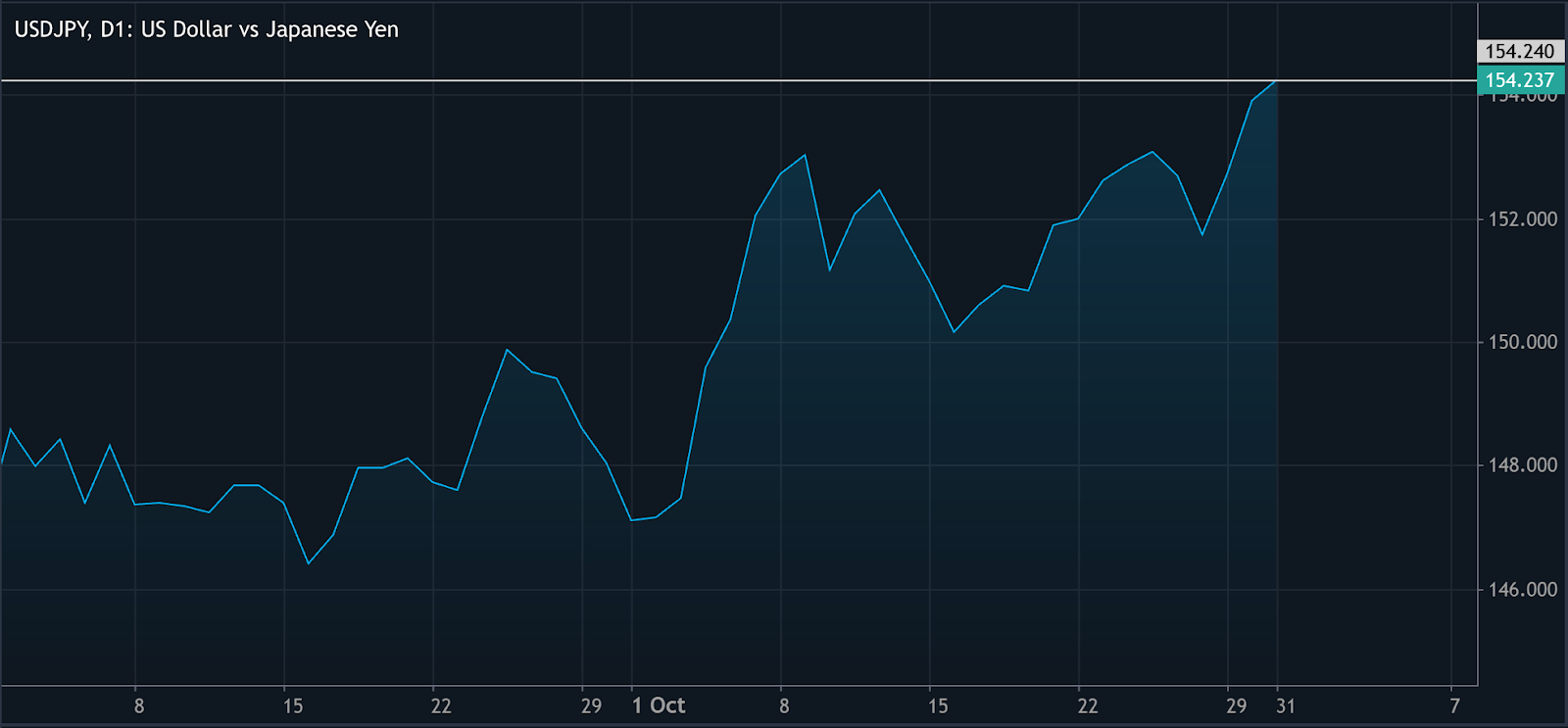USD/JPY forecast: Inside the psychological battlefield driving the yen

According to reports, USD/JPY’s surge past 154 per dollar underscores the growing divide between Japan’s cautious monetary policy and the U.S. Federal Reserve’s firmer stance. The yen’s weakness reflects more than interest-rate differentials - it’s become a test of confidence in Japan’s policy credibility.
Despite Tokyo’s inflation running above target and rising government concern, traders continue to test how far the Bank of Japan (BOJ) will allow the currency to slide. The central question: does the pair push toward 155, or does a BOJ policy pivot spark a sustained yen recovery?
Key takeaways
- BOJ inaction vs. Fed firmness: The BOJ kept rates steady, while Powell signalled that a December rate cut isn’t guaranteed - widening the yield gap.
- 154 as a market trigger: The level has become a psychological battleground for traders testing Japan’s tolerance for yen weakness.
- Inflation pressure builds: Tokyo CPI accelerated to 2.8% YoY, well above target, yet Ueda remains focused on wage growth before tightening.
- Government warnings lose bite: Finance Minister Katayama’s verbal interventions briefly supported the yen but failed to reverse sentiment.
- Risk of policy credibility erosion: Unless the BOJ takes decisive action, the yen could remain vulnerable to further depreciation and speculative pressure.
BOJ’s hesitation leads to Japanese yen weakness
The BOJ’s decision to keep rates unchanged reinforced market perceptions that Japan will stay behind the curve of global tightening. Governor Kazuo Ueda suggested a rate hike could come as soon as December, but stressed that sustained wage growth remains essential for policy normalisation.
In contrast, Federal Reserve Chair Jerome Powell’s cautious yet firm tone - hinting that another rate cut this year is not guaranteed - strengthened the dollar. This widening policy divergence continues to anchor USD/JPY above 154.

USD JPY at 154: Where psychology meets policy
The 154 level has evolved into a symbolic line between market conviction and policymaker caution, according to analysts. Traders recall previous interventions near similar levels and view 154 as the threshold of Tokyo’s tolerance.
Each government comment is now treated as a sentiment indicator rather than a credible warning. Brief yen recoveries after official remarks fade quickly without matching BOJ policy action. In this sense, the level represents a psychological battleground - one where traders, algorithms, and policymakers test each other’s resolve.
Japan inflation says “move”, policy says “wait”
Tokyo’s October CPI rose to 2.8% YoY, with core and core-core readings also above 2.8% - signalling broad-based inflation that’s been above the BOJ’s 2% target for over three years.

However, Ueda continues to emphasise wage-led inflation as the precondition for any tightening cycle. This cautious stance has created a credibility gap: inflation data suggest urgency, but policy rhetoric suggests patience. The result - investors perceive the BOJ as reluctant to respond decisively, reinforcing speculative yen selling.
Government warnings and the illusion of control
Finance Minister Satsuki Katayama’s recent warning that the government is monitoring FX moves with “a high sense of urgency” briefly lifted the yen to 153.65, before USD/JPY rebounded.
The move highlighted the short shelf-life of verbal interventions. Without direct market action, such warnings appear to acknowledge - rather than prevent - yen weakness. Tokyo’s “soft power” approach has lost influence, as markets now demand policy signals rather than rhetoric.
Traders weigh conviction vs caution in USD/JPY
Market participants see three potential paths ahead:
- Continuation: USD/JPY pushes through 155, forcing Tokyo’s hand on direct intervention.
- Correction: A surprise BOJ hike or coordinated move with U.S. authorities sparks a sharp yen rebound.
- Consolidation: The pair stabilises between 153–154, awaiting wage and inflation data.
Futures positioning shows speculative yen shorts at multi-month highs - meaning a sudden shift in sentiment could cause a fast, disorderly reversal.
Credibility becomes Japan’s real currency
Every move above 154 underscores a deeper issue: trust. The yen’s weakness now reflects investor scepticism about Japan’s willingness to tighten policy, not just interest-rate gaps.
Until the BOJ backs its rhetoric with action, markets will continue to test the limits of its tolerance, according to experts. The next 100 pips - between 154 and 155 - may determine whether Japan’s credibility holds or erodes further.
USD/JPY technical insight
At the time of writing, USD/JPY is trading around 154.28, hovering near its recent highs in what appears to be a price discovery phase. The pair has maintained a strong bullish momentum, riding the upper Bollinger Band - a sign of persistent buying pressure. However, such positioning often precedes short-term pullbacks as traders take profit.
The RSI is rising sharply toward overbought territory (above 70), suggesting that bullish momentum may be overextended. If RSI crosses into that zone, a corrective move could follow as buying enthusiasm cools.
Key downside levels to watch are 150.25 and 147.05, marked as notable support zones. A sustained break below 150.25 could trigger sell liquidations and accelerate downward momentum, while a deeper move under 147.05 would signal a broader shift in market sentiment.

USD/JPY investment implications
For traders, USD/JPY above 154 signals continued short-term bullish momentum for the dollar, underpinned by policy divergence.
- Short-term strategies may favour tactical long positions near support around 153.50–153.80, while monitoring for sudden verbal or direct intervention near 155.
- Medium-term investors should stay cautious. A surprise BOJ policy move or shift in Fed guidance could quickly unwind the trade.
- For portfolio managers, the yen’s volatility presents both carry trade opportunities and macro risk exposure, making Japan’s currency landscape the most psychologically charged market of 2025.
The key is to balance exposure by using Deriv’s trading calculators and position-sizing tools to manage risk in real-time.
Traders seeking to take advantage of the volatility can analyse setups on Deriv MT5 , where comprehensive charting and technical indicators support detailed yen analysis.
The performance figures quoted are not a guarantee of future performance.



